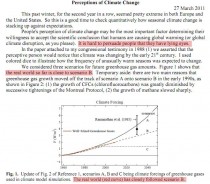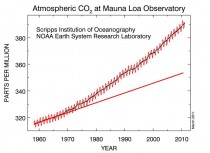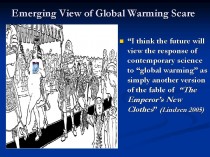By Ron Arnold, the Examiner from the SPPI blog
Inside the National Center for Environmental Economics, analysts scurried to finish the vital technical support document to fulfill President Obama’s most draconian campaign pledge: “Implement an economywide cap-and-trade program to reduce greenhouse gas emissions 80 percent by 2050.”
The NCEE was ready to cement the case for the Environmental Protection Agency’s “endangerment finding,” the official declaration that carbon dioxide from burning fossil fuels poses a threat to human health and welfare. Thousands of government careers, academic contracts, and Big Green grants hung in the balance, and EPA Administrator Lisa Jackson needed to release it within days.
But senior research analyst Alan Carlin, Ph.D., a 38-year EPA veteran never known as an ideologue, submitted his unlikely critique that the agency’s case was full of predetermined, politically mandated, cherry-picked scientific garbage.
Carlin criticized as many details as possible in the four days before the finding’s release: EPA had relied on outdated research and ignored major new developments, including declines in global temperatures, projections that hurricanes won’t get worse, and findings that ocean cycles best explain temperature fluctuations.
“I did the reasonable thing,” said Carlin. “I applied the scientific method to every study used in EPA’s technical support document,” as you’d expect from a man with a physics degree from CalTech and a Ph.D. in economics from Massachusetts Institute of Technology.
Alarmingly, he found more computerized guesswork and editing by advocates than observable results. Carlin urgently requested that his report be forwarded immediately to top decision makers.
The director refused. In an email to Carlin, he said, “The administrator and the administration has decided to move forward on endangerment, and your comments do not help the legal or policy case for this decision.”
Imperiling his career, Carlin explained that he knew where his duty lay concerning scientific truth and the administration, and got these appalling replies: “I don’t want you to spend any additional EPA time on climate change,” and, “Do not have any direct communication with anyone outside of NCEE on endangerment. There should be no meetings, emails, written statements, phone calls etc.”
The message: Dr. Carlin, hush your mouth. EPA Administrator Jackson and President Obama have made up their minds. Don’t bother them with facts. And don’t you dare tell the American public. Hush!
An outraged source in EPA who was not Carlin passed the whistleblower documents and emails to Sam Kazman, general counsel of Competitive Enterprise Institute, a Washington free-market think tank.
Kazman was astounded by the “Hush” emails, accepted the case, and began a successful campaign to make the suppression of Carlin’s report a cause celebre. A few days later, the Waxman-Markey cap-and-trade bill barely passed the Democrat-held House and the Senate warily let the measure die.
But EPA released its endangerment finding, which immediately faced an appeals court challenge.
As Obama’s much-touted “science-based policy” rotted into “policy-based science,” Big Green sycophants praised the administration in a quarter-page Washington Post ad.
And so we got Hushgate. That was two years ago. Two weeks ago, Carlin’s report, updated, expanded, and peer-reviewed, was published in the respected International Journal of Environmental Research and Public Health.
Carlin’s 47-page, no-nonsense report rips computer modeling, false comparisons between hypotheses and real-world data, and efforts to manipulate climate measurements.
Main points: The economic benefits of reducing CO2 emissions are vastly lower than EPA estimates, and the costs are vastly higher. Conclusion: “the risk of catastrophic anthropogenic global warming appears to be so low that it is not currently worth doing anything to try to control it.”
That will sorely test the influence of Environmental Defense Fund President Fred Krupp, who recently called for disdainful green groups to recognize their waning clout and “adopt a less arrogant approach that takes into account all sides of the global warming debate.”
Fat chance.
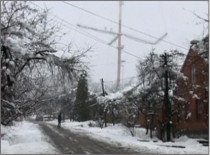
Heavy snow has caused damage in parts of North Ossetia. Locals say they haven’t seen this much snow in years.
April 13, 2011 - North Ossetia, Russia (Reuters) Snowfalls in Russia’s North Ossetia damage power and water supplies and make local television company suspend broadcasting due to TV tower accident.
A few days of heavy snowfalls in Russia’s southern republic of North Ossetia halted power and water supplies to the main city of Vladikavkaz and tore wires on the city’s TV tower on Wednesday (April 13).
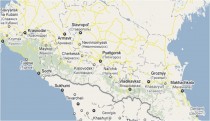
The streets leading to the tower were shut down by the city authorities and the local Alania television company had to suspend broadcasting because of the accident. The employees of the company were evacuated from the office building located right under the tower due to threats that it could fall down, Russian Interfax news agency reported.
According to the television company representative, the cable leading to one of the tower’s supporting polls tore down making it unstable. The TV company would halt its broadcasts for a couple of days, Alania representative told Interfax.
Local citizens said they did not have such a snowfall in years.
“The winter seemed to be quite warm this year, but there were heavy snowfalls in February and March. It’s the first time I see so much snow falling at once,” Elbrus Temirkhanov, who lives quite near the tower said.
However, Temirkhanov did not seem threatened by the danger of the tower falling down.
The authorities are now looking into a possibility of cutting off power from the tower and evacuating people living in nearby area, Interfax reported.
By Cyril Boynes, Jr.
If only the world cared as much about African children and families, as they do about dogs.
A couple months ago, when its dog-sledding business lost customers, a Canadian company had a hundred of its dogs killed. The incident “shocked” and “angered” people. The employee who shot the dogs said he suffered “post traumatic stress” from killing them and wants compensation.
Animal activists used the incident in campaigns against dog sled rides. “I don’t think society is willing to accept that animals should be killed just because they are surplus or don’t suit the purpose they were born for,” said one. “The magnitude of this atrocity is so shocking - our heads are reeling,” another said.
Huskies are beautiful, gentle animals, and I’m really sad that this happened. But the world needs to put this in perspective. Humans eat animals. Our cars kill them along highways. Wind turbines kill eagles and other birds. More important, what about people?
My wife Fiona Kobusingye lost her son, two sisters and four cousins to malaria. Her nephew is permanently brain-damaged because of it. Almost everyone I know has lost at least one child or sibling to this killer disease. Despite millions of bednets, malaria still kills more African children than any other disease.
I cannot help thinking it would really be nice if, just once in awhile, animal lovers, environmentalists, journalists and other people would care half as much about African babies, children and families, as about dogs.
A hundred dogs are killed, and activists and newspapers make it a huge story.
Last year, almost one hundred thousand Ugandan children and adults were killed by malaria. And yet, nobody seemed to care - certainly not enough to write a story about it, or get outraged that callous anti-pesticide activists lie about DDT risks and prevent the use of DDT and other insecticides that could prevent malaria, yellow fever and other diseases that cause so much suffering, poverty and death on our continent.
It’s as if anti-pesticide greens believe we Africans are “surplus” people on an “over-populated” planet and don’t “suit the purposes” they think people should be born for. It’s as if our misery and deaths don’t mean anything. This is the real atrocity, and our African heads are reeling.
Yes, government agencies, private foundations, school children and other kind people from rich, malaria-free countries do send bednets, so at least some babies and pregnant women can sleep under one. But nets get torn, people don’t always use them or hang them properly, and they only reduce malaria by 20 or 30 percent. That’s why we need additional weapons - like DDT and other insecticides.
DDT keeps most mosquitoes from even going into homes. It irritates any that do come in, so they are less likely to bite. It kills any that land on walls after a blood meal, so they can’t transmit malaria to other victims. DDT is cheap and long lasting: one spray is good for six months or more. No other chemical in existence does all this, at any price.
To break the transmission cycle and stop malaria, we need to reduce mosquito populations, keep them away from people, and treat infected people quickly. Nets are essential. So are better houses and hospitals (with screens on doors and windows), greater efforts to remove mosquito resting areas near homes, and access to the best possible drugs.
But we also need chemicals to kill mosquito larvae, insecticides to kill adults, and DDT as a long-lasting spatial repellant to keep mosquitoes out of our homes. We need every one of these weapons, not just the ones chemical-hating ideologues approve of, or we will forever be burying our children.
We are constantly told the DDT we spray on walls to keep mosquitoes out of our houses, and the insecticides we use to kill these insects, are dangerous, have undesirable side effects and shouldn’t be used. But as Dr. Rutledge Taylor explains in his new film, “3 Billion and Counting,” years of research actually prove that DDT is safe for people and the environment. And read The Excellent Powder, by Donald Roberts and Richard Tren.)
As Dr. Taylor points out, no one has ever died or been seriously hurt from DDT. Its worst effects are skin rashes and speculative (but unproven) connections to early lactation failure in nursing mothers and various other minor problems. Both Dr. Gordon Edwards and Dr. Taylor have actually eaten large amounts of DDT - and not been harmed.
We all know what malaria does. Besides lactation failure and low birth weights in babies, malaria makes people horribly sick and unable to work, leaves millions permanently brain-damaged, and kills millions more in the most awful, painful ways imaginable. Why anyone - especially Africans - would oppose using weapons that can stop this terrible carnage is impossible to imagine.
But a lot of people listen to the constant lies, told by baby-killing, pesticide-hating activists - and believe them. It’s bad enough that Greenpeace, Environmental Defense, Pesticide Action Network and the Stockholm Convention Secretariat tell these lies and want to ban DDT from malaria programs by 2020. It’s much worse that the Global Environment Facility, United Nations Environment Programme and even some bureaucrats in the World Health Organization support the ban.
But it’s unconscionable that Ugandan companies and politicians are doing it, too.
Organic food companies claim even a trace of DDT on their produce or flowers will keep them out of Europe. That is false. Their crops just cannot have DDT above certain levels - and that will not happen from DDT sprayed on walls. But what’s really absurd is that tobacco companies refuse to allow the barest detectable trace of DDT on cancer-causing tobacco that they are happy to sell to Europeans, and Europeans are happy to smoke.
It’s not just hypocrisy. For these companies, government agencies and activist groups to put their salaries, profits and ideologies ahead of the health and lives of African babies is immoral. It’s manslaughter.
Decisions about using DDT, larvacides and insecticides (along with nets and drugs) need to be made by African health ministers - not by activists, animal lovers, or environmental and agricultural interests. These groups are spending more money trying to get rid of DDT than the world is spending to control and eradicate malaria - when almost three billion people are at risk of getting this disease, and a million die from it, year after year.
We need to use DDT and other insecticides carefully - and we are doing so. However, in the end, if we don’t use them, our wonderful, brilliant, athletic, musical, hard-working children and parents will be struck down, brain-damaged and killed by malaria.
Or more accurately, they will be murdered by self-centered ideologues, businessmen, politicians, and even WHO and other medical doctors who are violating their oath to save lives.
This has to end. We need to get our priorities straight - and understand what the real risks are. We need to pray that this insane opposition to disease-preventing, life-saving chemicals will be replaced soon with a concern for babies and parents that is equal to their concern for sled dogs.
Cyril Boynes, Jr. is co-chair of the Congress of Racial Equality Uganda and a tireless advocate for health and prosperity in Africa and all other developing regions.
By Steve McIntyre, Climate Audit
In his written and oral evidence at today’s hearing before the House Science Committee, Kerry Emanuel made untrue statements about deletion of data to hide the decline. From Emanuel’s written evidence (oral was similar):
Consider as an example the issues surrounding the email messages stolen from some climate scientists. I know something about this as I served on a panel appointed by the Royal Society of Great Britain, under the direction of Lord Oxburgh, to investigate allegations of scientific misconduct by the scientists working at the Climate Research Unit of the University of East Anglia. Neither we nor several other investigative panels found any evidence of misconduct. To be sure, we confirmed what was by then well known, that a handful of scientists had exercised poor judgment in constructing a figure for a non peer-reviewed publication. Rather than omitting the entire record of a particularly dubious tree-ring-based proxy, the authors of the figure only omitted that part of it that was provably false. If this was a conspiracy to deceive, though, it was exceedingly poorly conceived as anyone with the slightest interest in the subject could (and did) immediately find the whole proxy record in the peer-reviewed literature.
The proxy in question is, of course, the Briffa reconstruction. Emanuel says that the authors “only” deleted the part of the reconstruction that was “provably false”, with the problem limited to a “non peer-reviewed publication”.
The Briffa network was developed from 387 sites anticipated to be temperature proxies because of their latitude or altitude. Emanuel has no basis for describing the Briffa network as “a particularly dubious tree-ring-based proxy”. It is an important large population and there is no evidence that the measurements were taken inaccurately. The NAS panel in 2006 did say that strip bark proxies should be “avoided” in temperature reconstructions. If Emanuel were seriously concerned about the use of “particularly dubious” tree-ring proxies, shouldn’t these be the ones that he should be worried about?
Emanuel’s evidence to the House Committee that the deletion of the decline was limited to a “non peer reviewed article” was also untrue. I presume that he is referring here to Phil Jones “combo trick” in the WMO 1999 report. As CA readers know, Keith’s Science Trick - the omission of part of the data - was systemic in the peer reviewed literature after 1999. Examples include the spaghetti graphs in Briffa and Osborn (Science 1999), Jones et al (Rev Geophys 1999), Briffa et al (JGR 2001) Plate 3, Jones et al 2001 Plate 2A, Briffa et al 2004 Figure 8, Hegerl et al Figure 5b. (CRU conceded most of this in their March 1, 2010 submission to Muir Russell, see page 38). Plus of course the spaghetti graphs in IPCC TAR and IPCC AR4.
Emanuel says that hide-the-decline was a “single lapse of judgement”. More disinformation on his part. The decision to “omit” part of the record was made over and over. It began in 1999, but continued unabated through IPCC AR4.
Worse, the practice was directly challenged by an AR4 reviewer (me). I requested IPCC to show the decline and explain it as best they could. I said that the deletion of the decline in TAR was misleading and asked that they not do so anymore. Briffa refused, merely saying that it would be “inappropriate” to show the decline. This was not a “single lapse of judgement”. It was something that’s gone on for over a decade.
Emanuel says that the “true scandal” is the elevation of hide-the-decline into a “sweeping condemnation of a whole scholarly endeavour”.
In my opinion, Emanuel and other senior members of the climate community bear much of the responsibility for the escalation of the incident beyond the borders of East Anglia and Penn State. If Emanuel and others wanted to stop criticism and suspicion, they should have carried out their inquiries in a systematic way, as inquiries are carried out in other fields.
The Oxburgh inquiry, of which he was a member, should have had written terms of reference, should have interviewed critics as well as CRU, should have had (at least) transcripts of the interviews - among other things.
The Oxburgh “report” was an insult to the public. Emanuel shares the blame for that.
That Emanuel, a member of one of the inquiries, should be unaware that hide-the-decline occurred in peer reviewed literature and IPCC merely proves, if anyone were in doubt, that the inquiries were cavalier and negligent rather than thorough and diligent.
More on Emanuel and Muller testimony in this Climate Depot compilation.
By Robert Felix, Iceagenow
28 Mar 11 - Although the media has done a great job of covering this up, the inconvenient fact is that all seven glaciers on California’s Mount Shasta are growing. This includes Whitney Glacier, the state’s largest.
Yes, growing. Not melting.
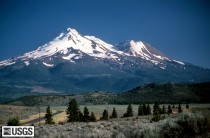
Mount Shasta and Shastina, California. USGS Photograph taken by Lyn Topinka, 1984
See post here on California snown season. Not only are Mt. Shasta’s glaciers growing, two have nearly doubled in size.
Both the Hotlum and Wintun Glaciers have nearly doubled in size since 1950, says this article on Wikipedia. The Bolam Glacier has increased by half, while the Whitney and Konwakiton Glaciers have grown by a third.
Scientists first became aware of these growing California glaciers in 2002, and I began writing about them in 2003. Now, eight years later, most media outlets still refuse to acknowledge that these glaciers are growing.
After this year’s record snowfall, it will become harder to continue the deception.
Record snowfall
With a record 98 inches of snow during the month of March, and an estimated 6 feet of new powder during the past week, the Mt. Shasta Ski Park is extending its ski season, said an article yesterday on redding.com.
On Monday, the ski park had nearly 22 feet of snow at the top and more than 8 feet at its lodge.
The City of Mount Shasta, sitting at the foot of the mountain about midway between San Francisco and Portland, Oregon, has broken a 108-year-old snowfall record for March with 97.9 inches, according to the National Weather Service. The old mark of 88 inches was set in 1903. For the season, 289 inches (24 feet) of snow has fallen on the city.
With all of this snowfall, I expect to see more glacier growth on California’s fifth tallest mountain.
Glaciers also growing in Washington and Alaska
But here’s the kicker.
Not only on Mt. Shasta, glaciers are also growing in Washington and Alaska.
Look at Washington State. The Nisqually Glacier on Mt. Rainier is growing. Glaciers on Glacier Peak in northern Washington are growing. And Crater Glacier on Mt. Saint Helens is now larger than it was before the 1980 eruption.
Or look at Alaska. Glaciers are growing in Alaska for the first time in 250 years. Two years ago in May, Alaska’s Hubbard Glacier was advancing at the rate of seven feet (two meters) per day - more than half-a-mile per year. In Icy Bay, at least three glaciers advanced a third of a mile (0.5 km) in one year.
Fifth-largest ice field in the Western Hemisphere also growing
And the Juneau Icefield, which covers 1,505 square miles (3,900 sq km) and is the fifth-largest ice field in the Western Hemisphere, is also growing.
According to Michael Zemp at the University of Zurich - one of the scientists that Al Gore likes to quote - “some positive values were reported from the North Cascade Mountains and the Juneau Ice Field.” ("Positive values” means “growing”.)
The fifth largest ice field in the entire Western Hemisphere is growing, and no one is bothering to report it.
The next time someone tries to guilt you with talk of melting glaciers, ask if they’re aware that glaciers are growing on Mt. Shasta, and in Washington, and in Alaska.
Ask if they’re aware that the fifth largest icefield in the Western Hemisphere is also growing.
They’ll probably be angry that you bothered them with such inconvenient facts.
See ”Mt. Shasta Ski Park extends season after record snowfall”. Thanks to Clay Olson for this link.
By Steven Goddard
Hansen says that he was right, your eyes are lying, and the world really is actually heating out of control. For some reason though, he forgot to include the actual temperature graph.
Hansen’s graph above shows what he claims has happened with emissions - a straight line. But the Mauna Loa CO2 graph below shows that CO2 has actually increased exponentially since 1960.
The graph below shows the Mauna Loa data plotted in green on top of Hansen’s graph - exactly following scenario A.
The graph below shows Hansen’s 1988 temperature projections vs. the GISS trend since 1960. Well below scenario B and even below scenario C.
Conclusion : Hansen is wrong about both CO2 growth and temperature change - even using his own bloated temperature numbers. Climate sensitivity is much lower than he projected. It is time for him to come clean about this.
See Steve’s full post and comments here.|
Hans Schreuder writes
“Climate sensitivity is much lower than he projected. It is time for him to come clean about this.”
Truth: “climate sensitivity” is ZERO. Time to come clean is not just for Hansen you know ....
See here, here and here. Does the emperor really have no clothes???
The Explorer Team completed the first phase of their expedition late last night when they arrived at the Catlin Ice Base.

The team has faced arduous conditions on their 77 mile route as fierce cold, strong winds and snowstorms battered the region. Their trek across the Prince Gustaf Adolf Sea took 10 days in temperatures dipping as low as -42C.
Despite the harsh winter conditions, they have achieved their objective of capturing data for scientists working on changes to the Arctic Ocean and their impacts.
Speaking from the Ice Base co-team leader Ann Daniels said the short but challenging first phase of the expedition had given them an opportunity to bring back data from an area of special interest to scientists. Water flows through this area from the Arctic Ocean to the North Atlantic.
“Some of the ice we crossed was really thick multi-year ice that was just too thick to drill through. Our drill goes to four and a half metres and it wasn’t breaking through. In other areas we were able to drop our measuring devices down to a depth of 200 metres below the floating ice.”
“It was pretty tough going. The hardest thing for us was surviving the worst of the weather. You know it’s brutal when you are glad it’s only minus 30 Celsius. Even then, as it ‘warmed’ we then experienced snowstorms and high winds.”
The team is resting for the next few days before redeploying to begin a much longer 300 nautical mile trek from the region of the North Geographic Pole towards Greenland.
The third Catlin Arctic Survey focuses on the vital role the Arctic Ocean plays in driving powerful ocean currents. The explorers are gathering data for scientists concerned that greater volumes of melted sea ice are ‘freshening’ the ocean and may be unbalancing the processes which sustain these currents. Any change to the conditions influencing these ocean currents could have impacts far away from the Arctic as they carry heat and nutrients around the world’s oceans. One consequence could be altered weather patterns of northern Europe, North America and even parts of Asia.
Icecap Note: As we have shown, the arctic reacts to multidecadal changes in the other oceans and on the sun not CO2. Also forecasts from climate models predicted the opposite state of the arctic oscillation and global patterns in winter as we showed here. H/T Tom Nelson and Marc Morano.
By John McLean, Climate Realists
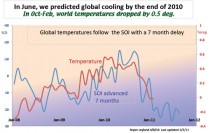
CLICK for LARGE VERSION of graph
MEDIA STATEMENT
For Immediate release
COOL YEAR PREDICTED
It is likely that 2011 will be the coolest year since 1956, or even earlier, says the lead author of a peer-reviewed paper published in 2009:
Our ENSO - temperature paper of 2009 and the aftermath by John McLean
The paper, by John McLean, Professor Chris de Freitas and Professor Bob Carter, showed that the Southern Oscillation Index (SOI), a measure of El Nino-Southern Oscillation (ENSO) conditions, is a very good indicator of average global atmospheric temperatures approximately seven months ahead, except when volcanic eruptions cause short-term cooling.
The lead author, McLean, points to a fall in temperatures that began in October last year, seven months after the abrupt shift to La Nina conditions, and according to last month’s data is still continuing.
“The delayed response is important for two reasons.” McLean says, “Firstly the high annual average temperature in 2010 was due to the El Nino that ended around March but whose delayed effect on temperature continued until late in the year. Secondly it means that the ENSO conditions can be used to predict with reasonable confidence the average global temperatures up to seven months ahead.”
Several previous scientific papers have discussed the delayed response, including two by critics of McLean’s paper. Although the other papers used different data sources they came to similar conclusions about the delay.
The key question is how much influence the ENSO has on average global temperature. McLean says that this is difficult to determine, because both can be affected by short-term events such as wind, clouds and tropical storms, but the sustained close relationship in the data of the last 50 years shows the influence is significant.
“The historical data also casts serious doubt on the hypothesis that carbon dioxide causes dangerous global warming,” says McLean. “Since 1958 there’s been a 30% increase in atmospheric carbon dioxide and if this had a major influence on temperature we’d expect to see clear evidence of the temperature continually rising above what the SOI suggests it should be, but this is not happening”.
The Bureau of Meteorology reports that ENSO models currently indicate that the La Nina will be with us well into autumn and fade slowly to neutral conditions by June. Taking into account the seven-month time lag it is likely that 2011 will be the coolest year since 1956 or even earlier, McLean says.
He also says that records show the oceans absorb more carbon dioxide during a La Nina event than during an El Nino, which means that the increase in atmospheric carbon dioxide in 2011 is likely to be less than in recent years.
ENDS
Nature defeats UN’s climate body, yet again
McLean, Carter and de Freitas published their landmark paper in 2009. It provides scientific proof that global atmospheric temperature rises and falls with the Southern Oscillation (El Nino, La Nina).
Influence of the Southern Oscillation on tropospheric temperature JOURNAL OF GEOPHYSICAL RESEARCH, VOL. 114, D14104, doi:10.1029/2008JD011637, 2009
The UN’s climate body became worried. Leaked Climategate scandal e-mails advocated conspiring to knock out the paper by any means. Scientific publishing guidelines were breached trying to knock it out.
Nature though proves McLean et al correct.
American weatherman Joe D’Aleo verifies impacts of El Nino and La Nina on global temperatures.
US Temperatures and Climate Factors since 1895 by By Joseph D’Aleo, CCM, AMS Fellow
Why are government and Greens climate policies based on UN climate misrepresentations and fraud?
Malcolm Roberts
Brisbane, Australia





